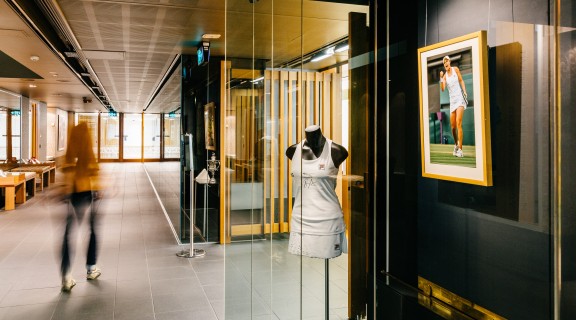
- Home
- Previously displayed
/
Previously displayed
Discover collection items previously featured on the Talbot Family Treasures Wall.
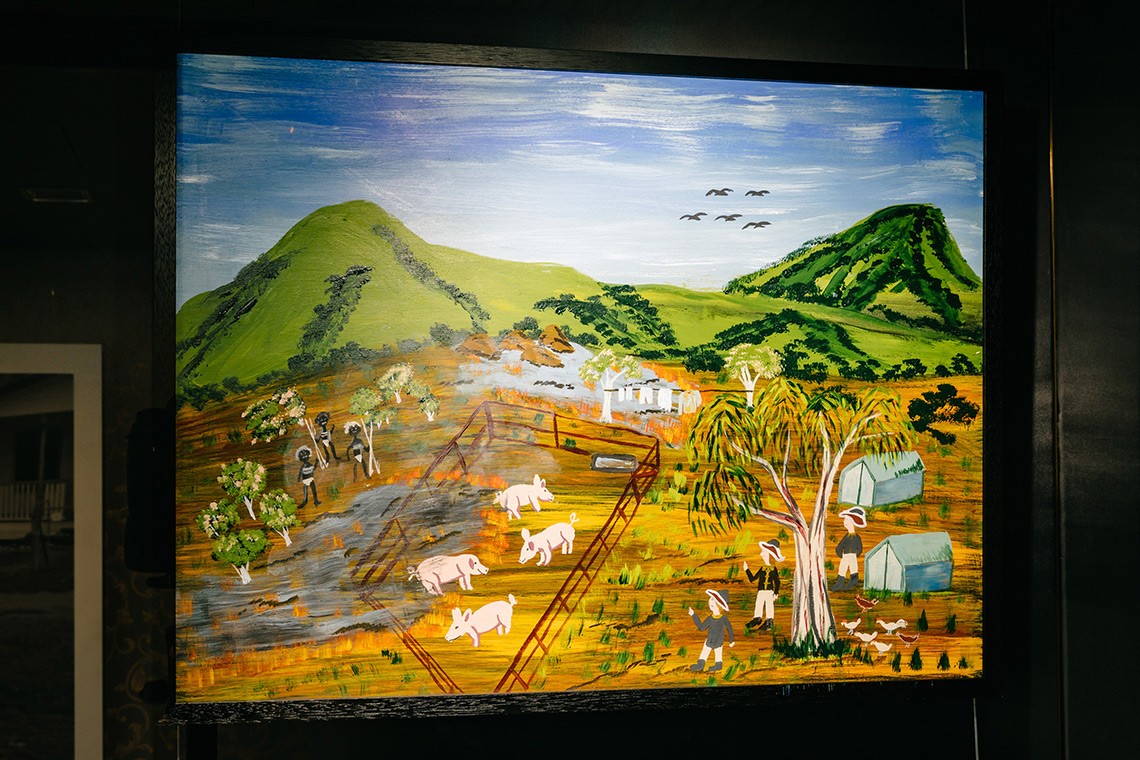
Burning the Pigs, 2020
Wanda Gibson
Born in Woorabinda in 1946, Indigenous artist Wanda Gibson Wanda is a Nukgal Wurra woman of the Guugu Yimithirr people (on her mother’s side). She grew up in Hope Vale on the Cape York Peninsula. Wanda created these paintings for the 2020 Undercurrents exhibition (a satellite exhibition to the Cairns Indigenous Art Fair). The exhibition addressed the imbalance of colonial (written) history versus First Nations’ (oral) history. Wanda’s paintings depict the First Nations’ oral history of Captain Cook’s landing at Endeavour River.
Burning the Pigs - ‘Cook brought with him pigs and livestock on his boat. On the first day he landed, he set up a pen on the beach to keep the pigs in. The Bama did not know what those pigs were, or what he was doing. So one day, the Bama set the pig pen on fire and burned it down. Cook didn’t like that. He got angry and fired guns at the Bama. Some of the pigs escaped the pen and ran into the bush. We still hunt and eat them today.’
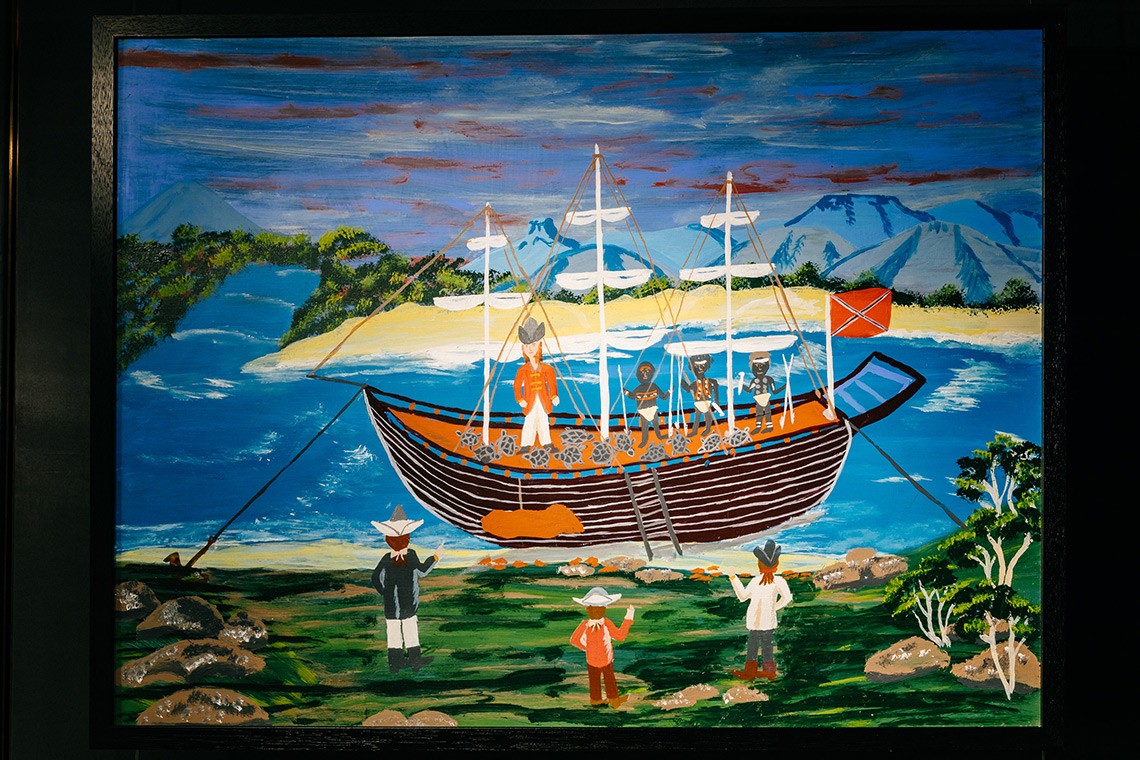
Twelve Turtles, 2020
Wanda Gibson
Twelve Turtles - ‘Cook and his men were hungry. They went out and hunted turtles. They were easy pickings. However, Cook didn’t understand our law. The turtle is very sacred to us. There are many cultural protocols around the hunting and butchering of the animal. Bama saw twelve turtles on board Cook’s ship. They got very upset and angry and even tried to throw the turtles over the side of the ship but Cook’s men stopped them. This is when the trouble started. Bama came back to Cook’s camp with spears and weapons. Cook’s men fired shots and some Bama were hit, but not killed. It was a very scary situation. There could have been serious bloodshed.’
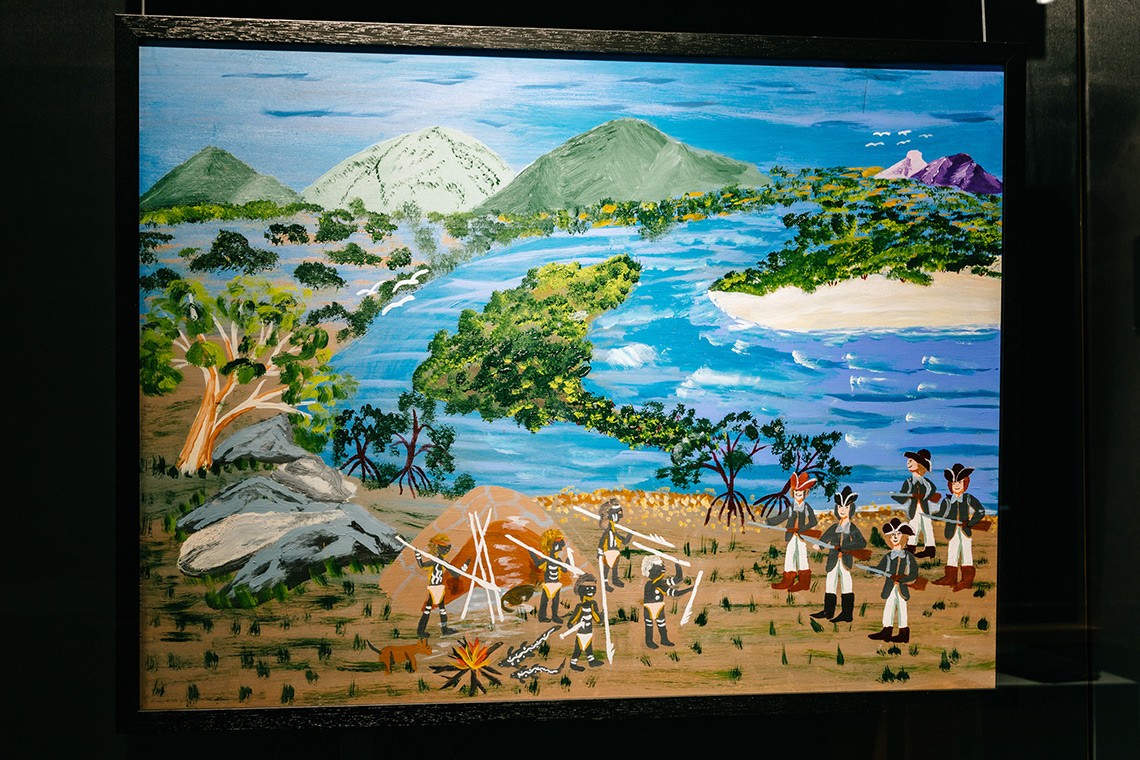
Defending our Camp, 2020
Wanda Gibson
Defending Our Camp - ‘Tensions ran high between the Bama and Cook’s men at first. The Bama thought that Cook’s men might be evil spirits, and Cook’s men were scared of the Bama and they wanted to hurt us.’
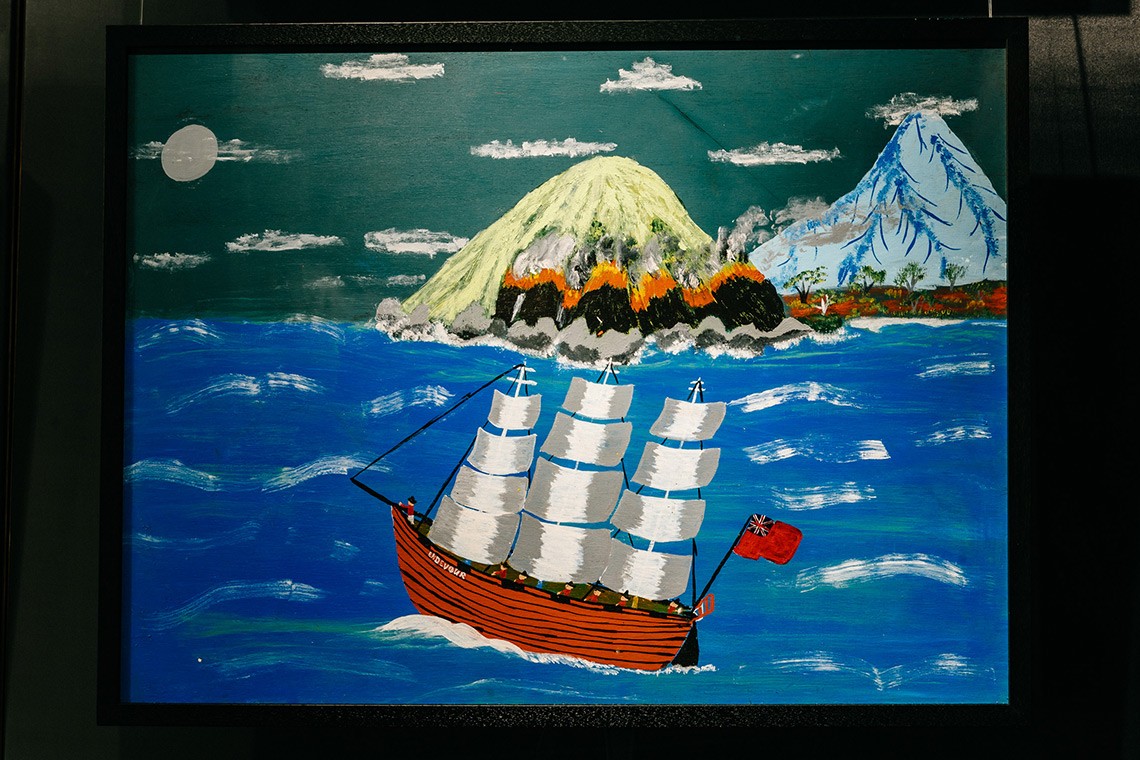
Sail Away, 2020
Wanda Gibson
Sail Away - ‘On the night that Cook and his crew left our country, the Bama set fire to the land and to the mountains around the area to try and get rid of the bad spirits. This tradition is still something we do today - some people call it a ‘smoking ceremony’. The Bama thought that they were gone and would not come back. They were wrong. I wish they knew then what we know now.’
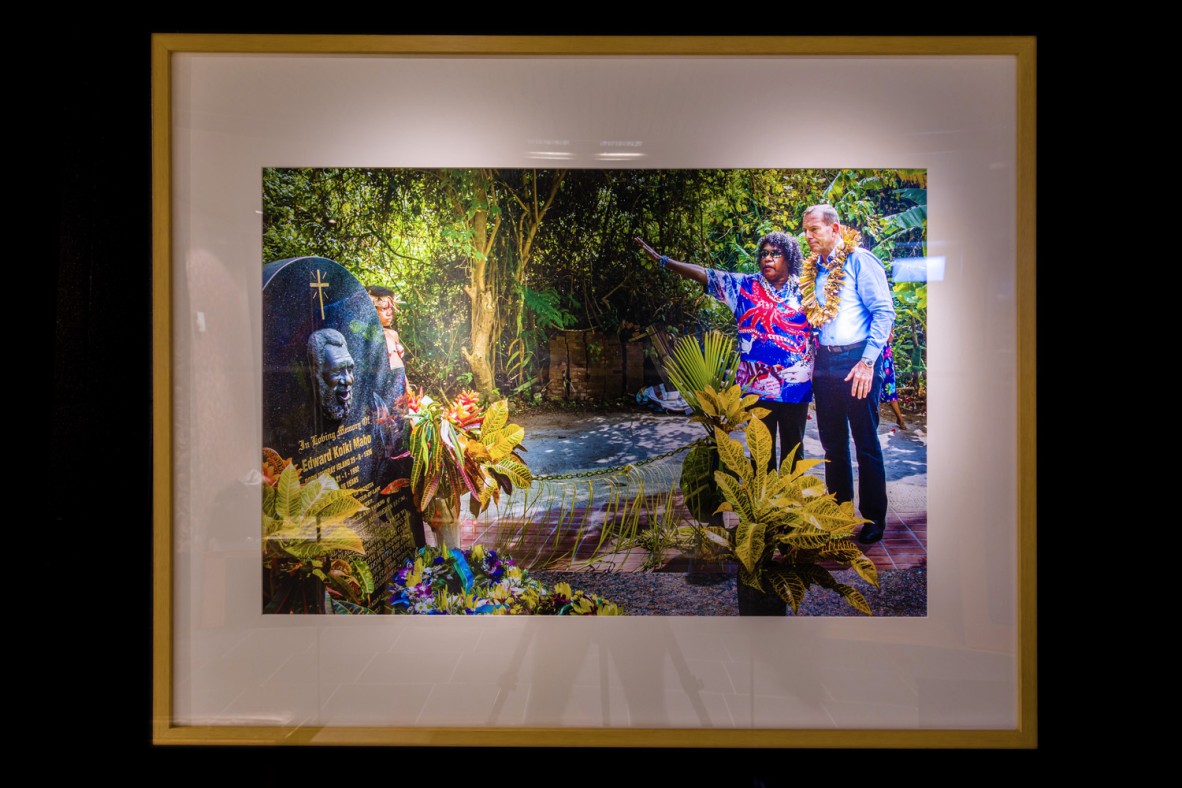
Prime Minister Tony Abbott’s Torres Strait tour photographs, 2015
Brian Cassey
Photograph of Tony Abbott with Gail Mabo, the daughter of Eddie Koiki Mabo, on Mer Island during the Prime Minister’s 2015 tour of the Torres Strait. Tony Abbott visited the grave of Eddie Mabo where he laid a wreath. The Prime Minister acknowledged Eddie Mabo as “a giant of your island and of your people. He was a warrior who fought for justice and now he rests amongst the other warriors of your people” (Sydney Morning Herald, 24 August 2015).
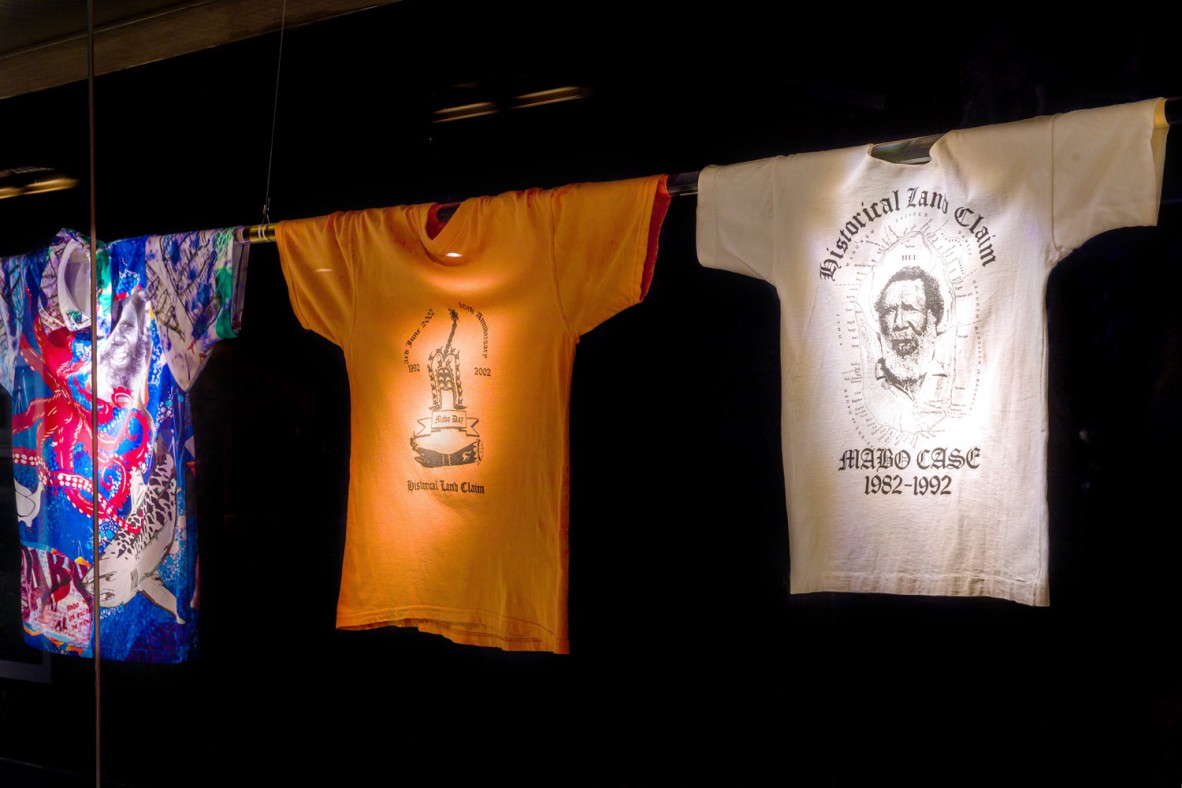
Mabo Family Collection
Mabo Family
Three printed shirts, worn by members of the Mabo family, which celebrate the landmark Mabo High Court case for Indigenous land rights in the Torres Strait.
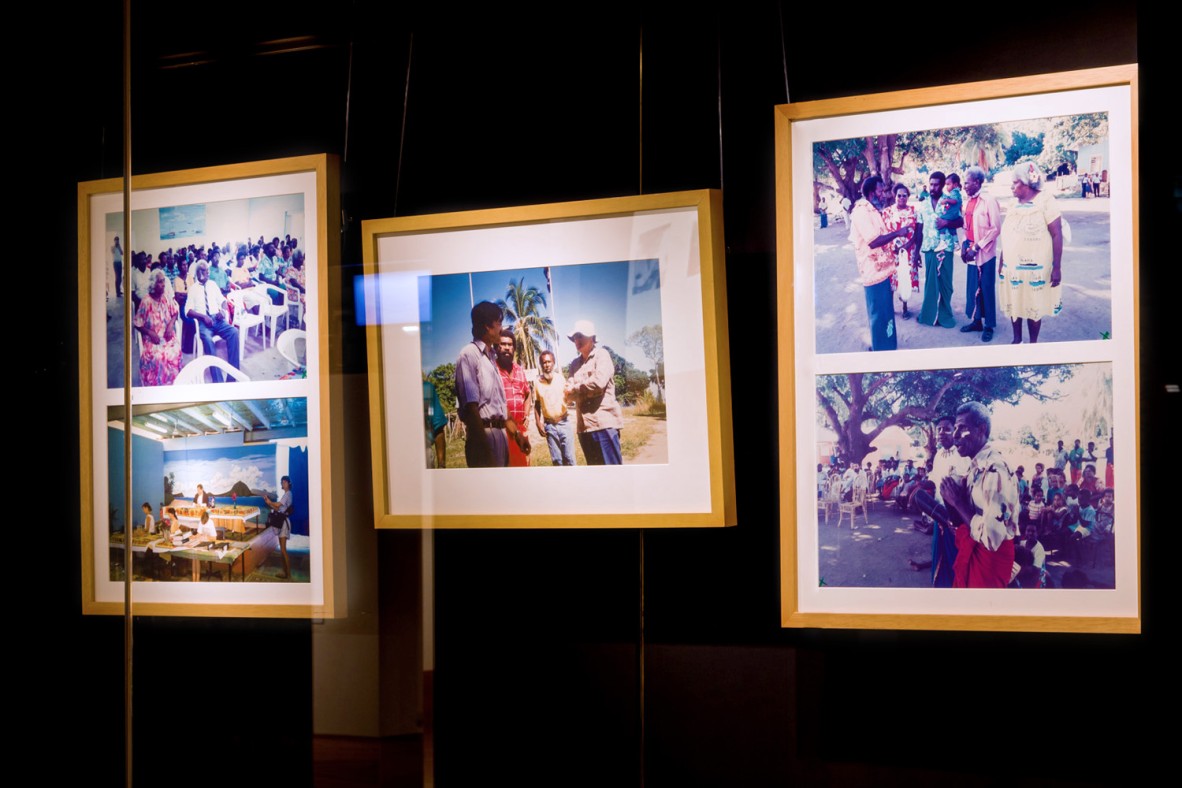
Photo print reproductions from the Mabo Case photograph album on Mer Island, 1989
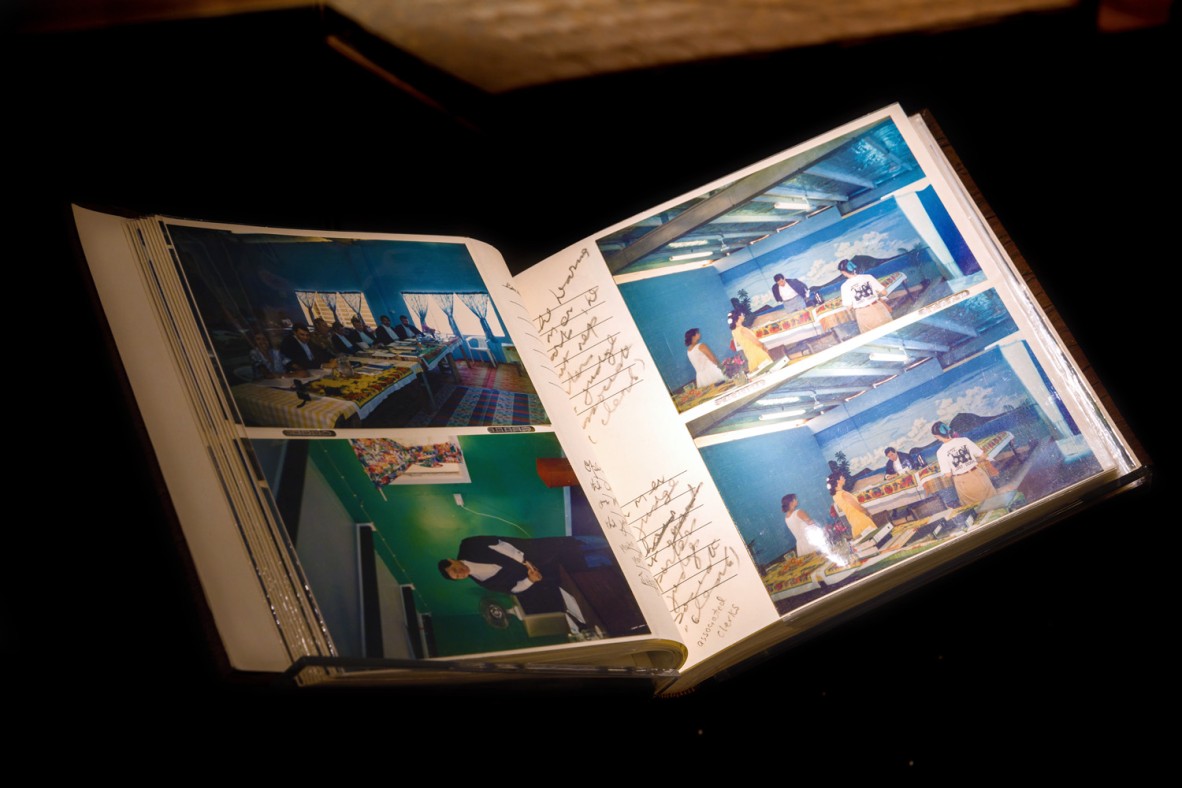
Album of Photographs Relating to the Mabo Case on Mer Island, 1989
Patricia Smith
This photograph album documents the hearing held by Queensland Supreme Court Justice Martin Moynihan on Mer Island in May 1989. The hearing was held on the island to take testimony during the Mabo versus Queensland court case, a landmark case that eventuated in the High Court of Australia’s decision in 1992 to recognise native title in Australia. The photographs include various personalities involved in the case such as Justice Moynihan, Eddie Koiki Mabo, and the people of Mer Island, as well as documenting the set-up of the courtroom and the welcomingceremony for the visitors to the island.
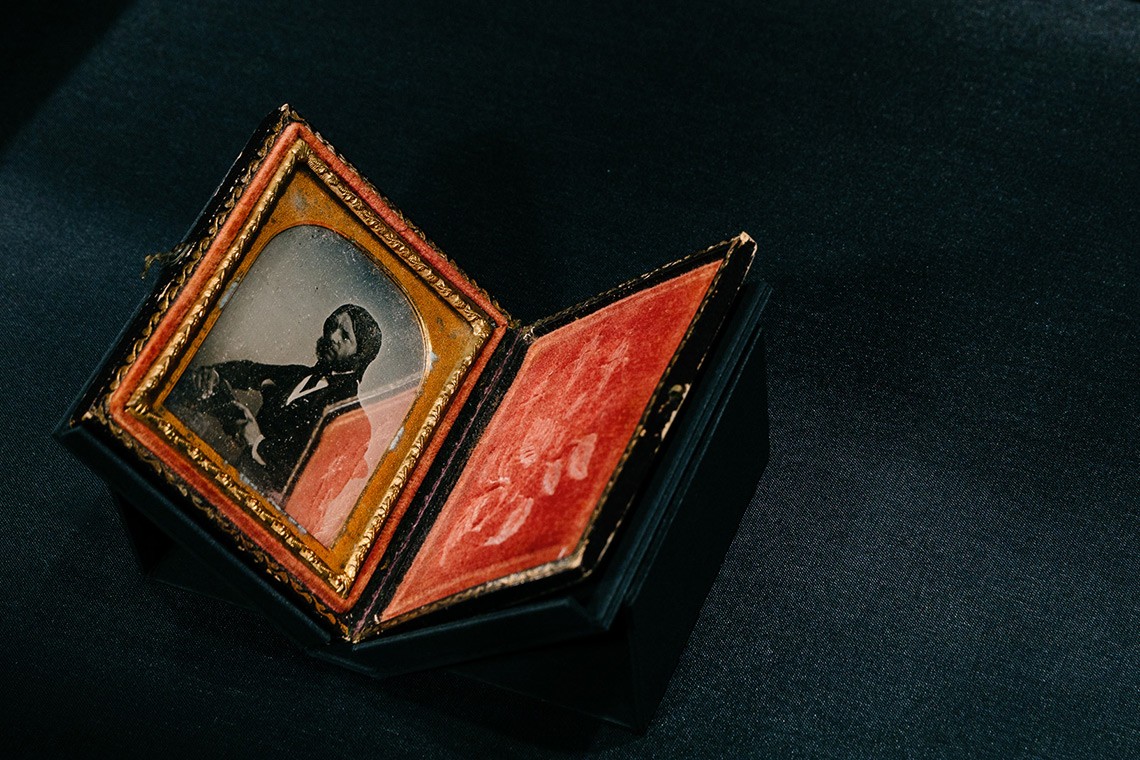
Daguerreotype image of Gustavus Birch, 1873-1874
Gustavus John Birch, 1820-1883
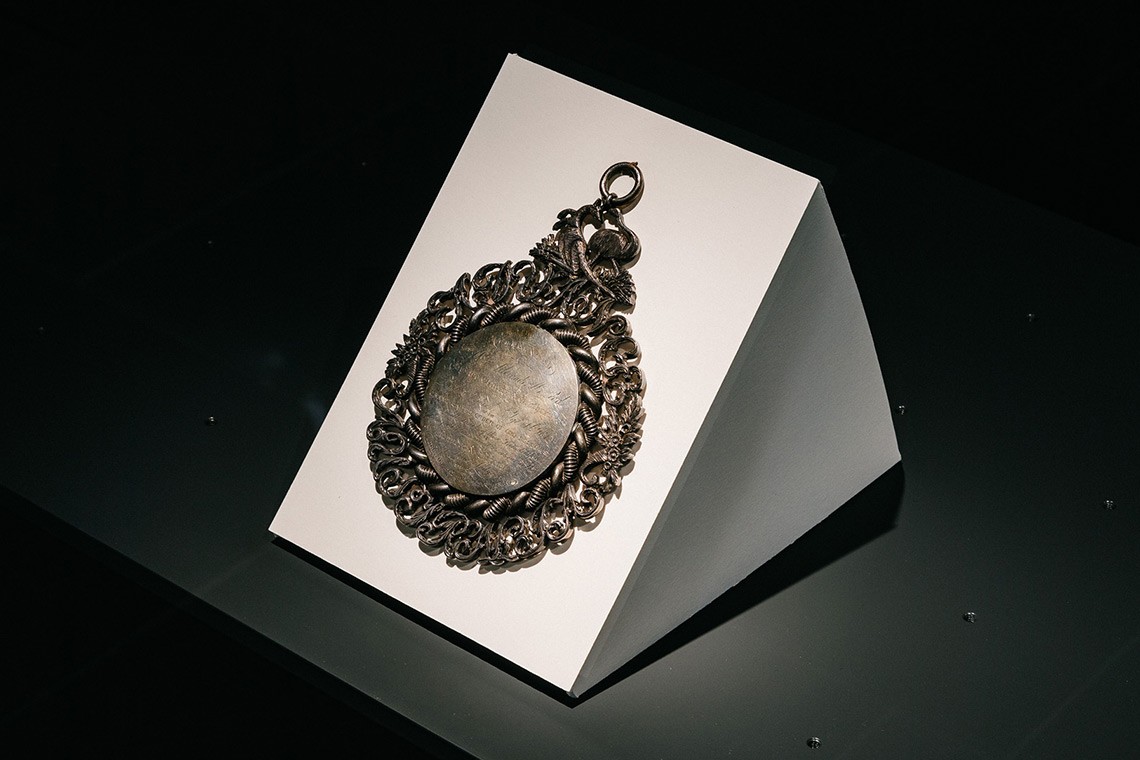
Loyal Ipswich Lodge Grand United Order of Odd Fellows Medallion, 1850
Joel John Cohen; Loyal Ipswich Lodge of the Grand United Order of Odd Fellows
Silver Medallion by Sydney silversmith Joel John Cohen commissioned by the Loyal Ipswich Lodge of the Grand United Order of Odd Fellows, and presented to founder Alexander McLeod, Moreton Bay, August 20th 1850, to mark the first anniversary of the Odd Fellows’ establishment. The Grand United Order of Odd Fellows was a friendly society, dedicated to providing for individuals and their families in times of sickness and adversity, and comprising “men of really good character”, anxious to improve the moral condition of their town.
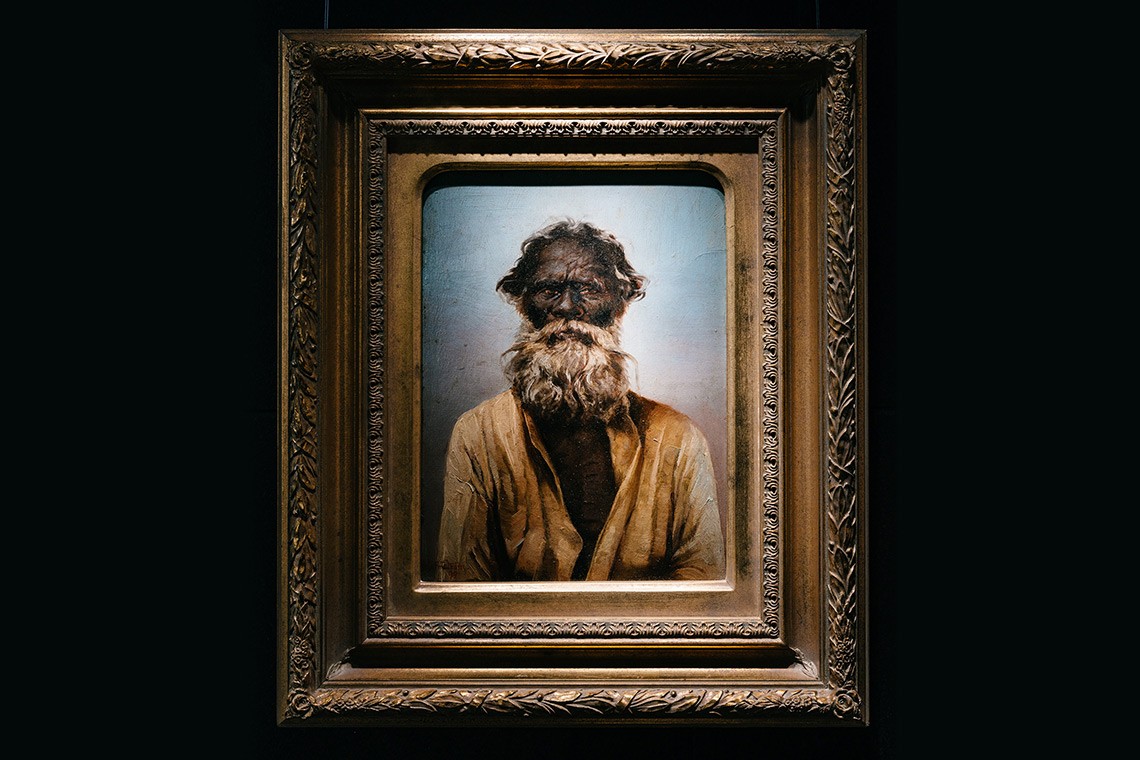
Portrait of King Sandy, 1899
Carl Magnus Oscar Fristrom, 1856-1918
This oil painting by Swedish born artist, Oscar Fristrom, is believed to depict ‘King Sandy’, one of the last surviving Brisbane district Aboriginal people. His Aboriginal name was said to be ‘Gairbaillie’ or ’Ker-Walli’ (meaning spilt). ‘King Sandy’ is believed to have died at Wynnum in 1900. The work is signed at the bottom left ‘O. Fristrom 99’. Oscar Fristrom is first recorded in Brisbane in 1884 where he became a photographer and later a successful painter, noted particularly for his fine portraits. His many Aboriginal portraits, such as the one of ‘King Sandy’, are of great historical importance as early recordings of Queensland’s Indigenous people.
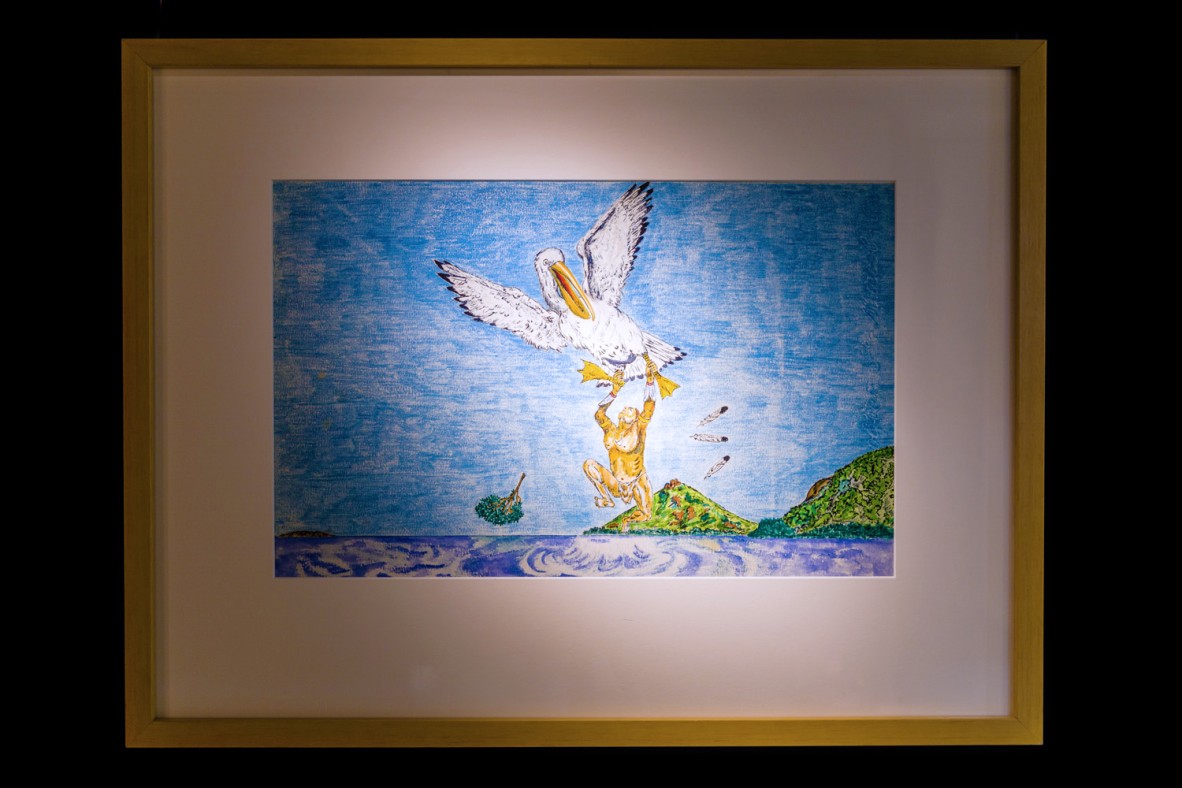
Amipuru
Bani Ephraim
This watercolour painting was published as the dust jacket illustration of Margaret Lawrie’s Myths and Legends of Torres Strait (1970). The painting illustrates the story of the fisherman Amipuru of Wagedagam who tried to catch a pelican so he could give it to his children as a pet. Amipuru grabbed the pelican’s leg and was carried through the air until he fell to the ground and sank into the mud up to his neck. The villagers tried to dig him out, but he kept sinking so the head man cut off Ampuru’s head with a bamboo knife. Amipuru’s wife and children wept.
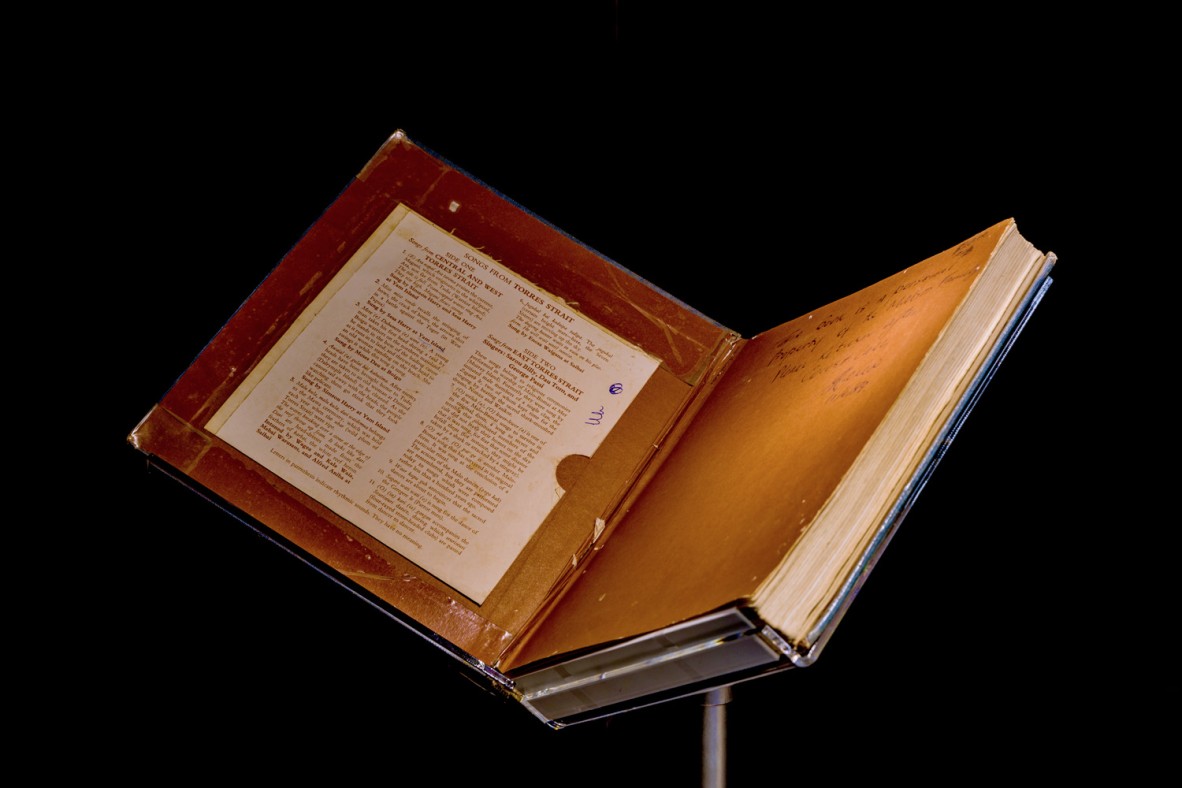
Mabo Family Collection
Mabo Family
Mabo family’s annotated copy of Margaret Lawrie’s publication Myths and Legends of the Torres Strait which was used during the sittings of the Queensland Supreme Court on Mer Island in May 1989. This landmark case led to the High Court of Australia’s decision in 1992 to recognise native title in Australia.
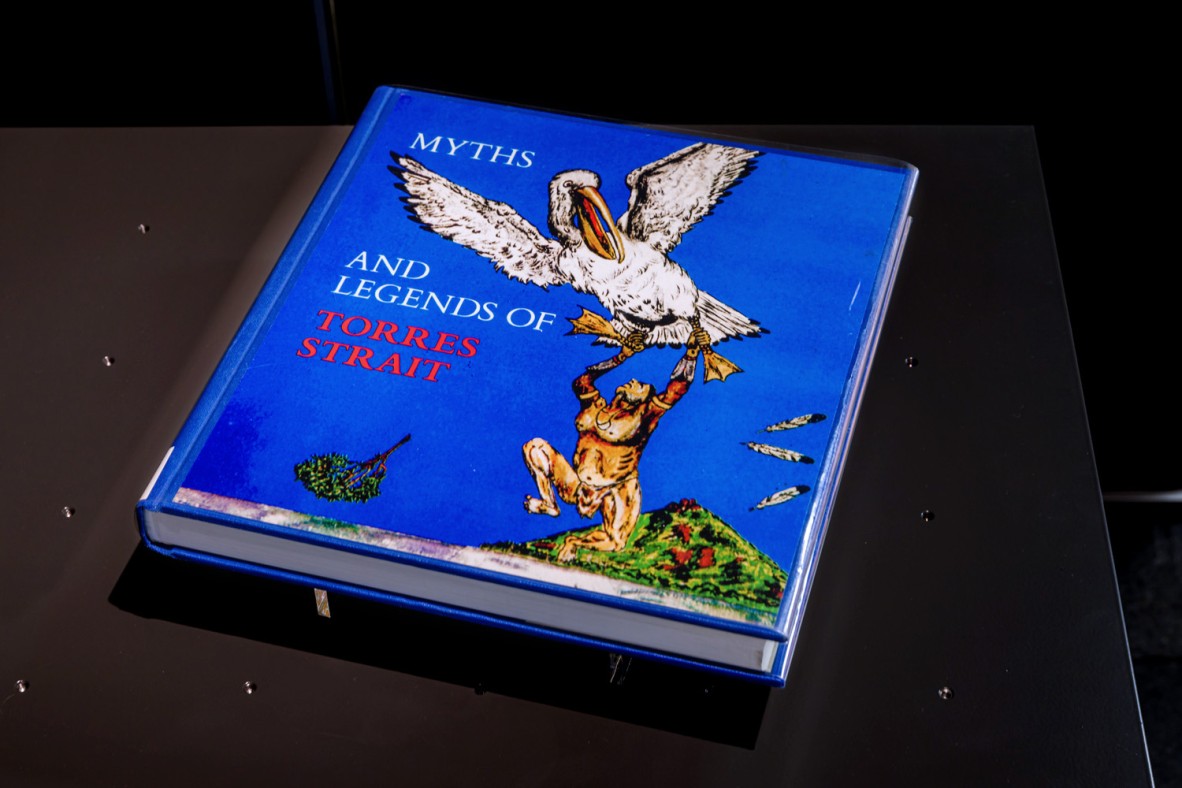
Myths and Legends of Torres Strait /collected and translated by Margaret Lawrie, 1970
Margaret Elizabeth Lawrie
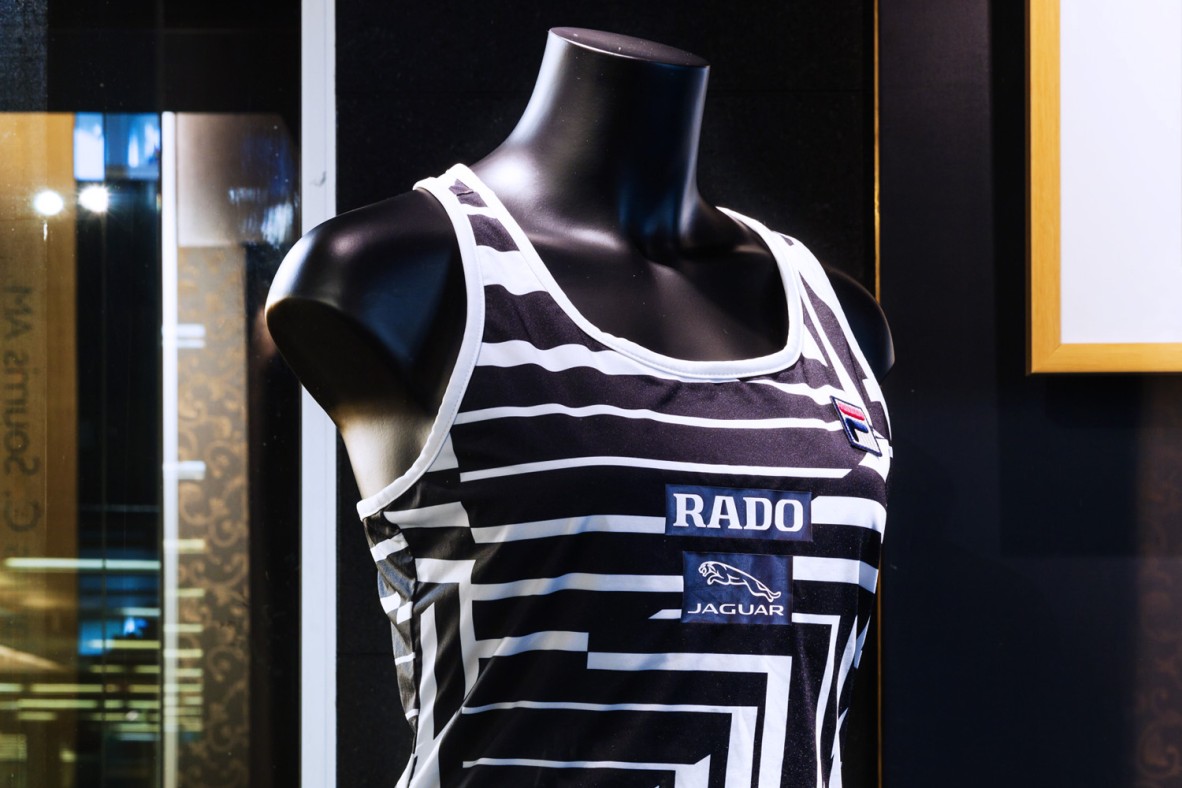
Ashleigh Barty French Open 2019 Outfit
Black and white FILA outfit worn by Australian tennis champion Ash Barty for her winning final at the 2019 French Open. The win was Barty’s first Grand Slam singles title. She became the first Australian to win the French Open singles title since Margaret Court in 1973.
Read more about Ash Barty's iconic Grand Slam outfits which are now part of the collection.
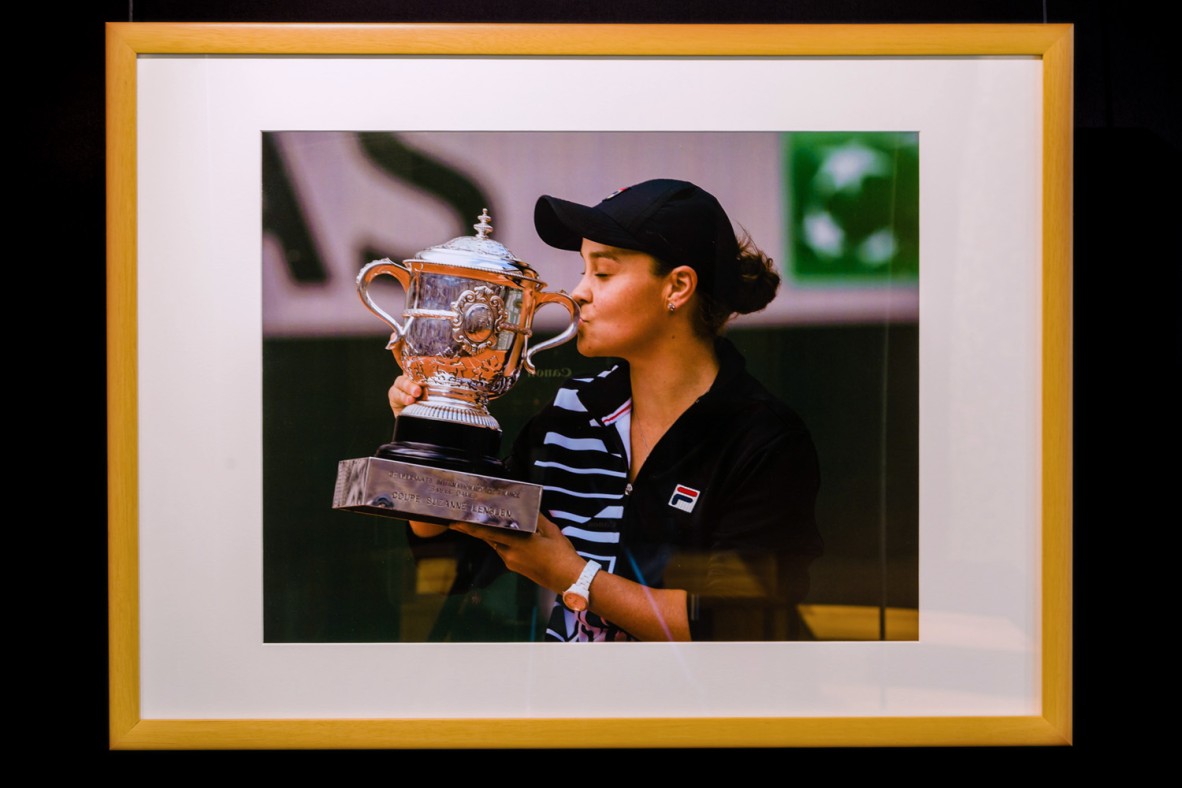
Photograph of Ash Barty kissing the winner’s cup at the French Open, 2019
Ashleigh Barty French Open 2019 outfit and photograph
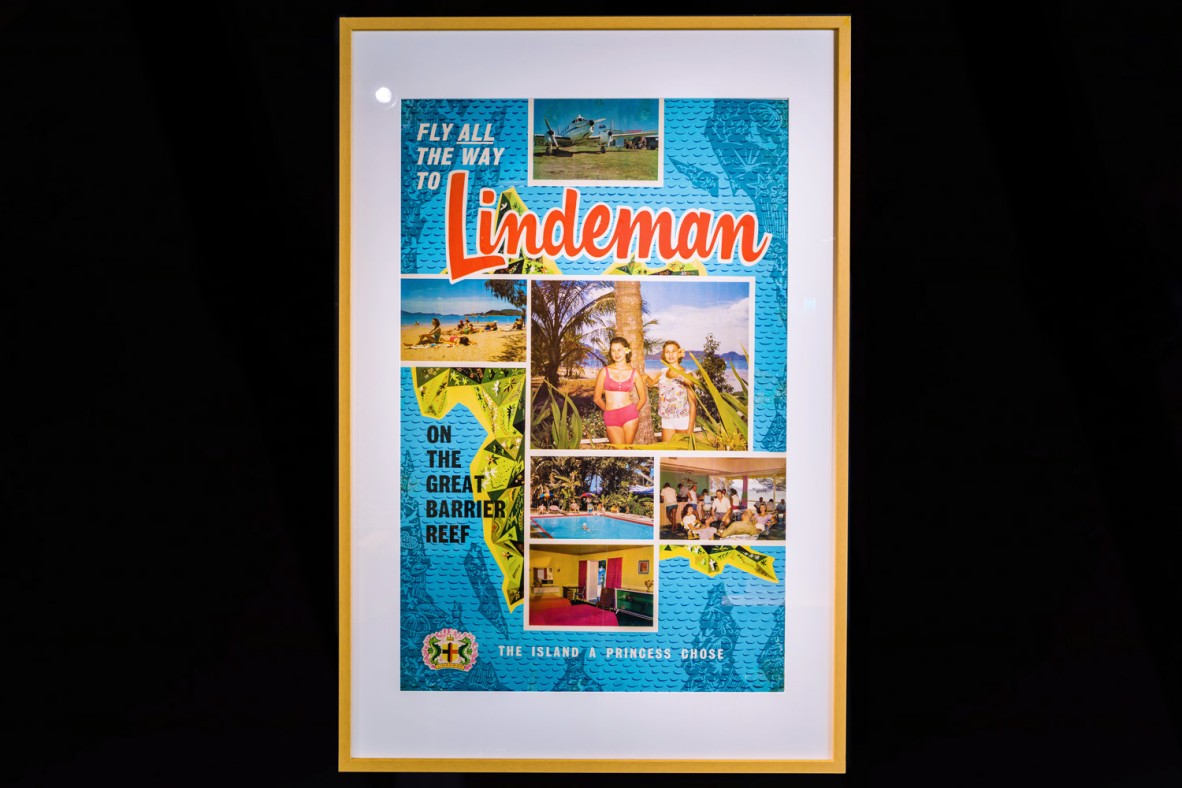
Fly all the way to Lindeman on the Great Barrier Reef, the island a Princess chose, ca. 1960
Creator Unknown
Princess Alexandra of Kent, the first cousin of Queen Elizabeth II and a popular young royal, visited Queensland in 1959 as the Queen’s representative for the state’s centenary celebrations. The Princess enjoyed a short break on Lindeman Island during the tour. In 1957 an airport was opened at Proserpine which allowed direct transfer by smaller aircraft to the Lindeman Island airport, thus eliminating the need to arrive by boat.
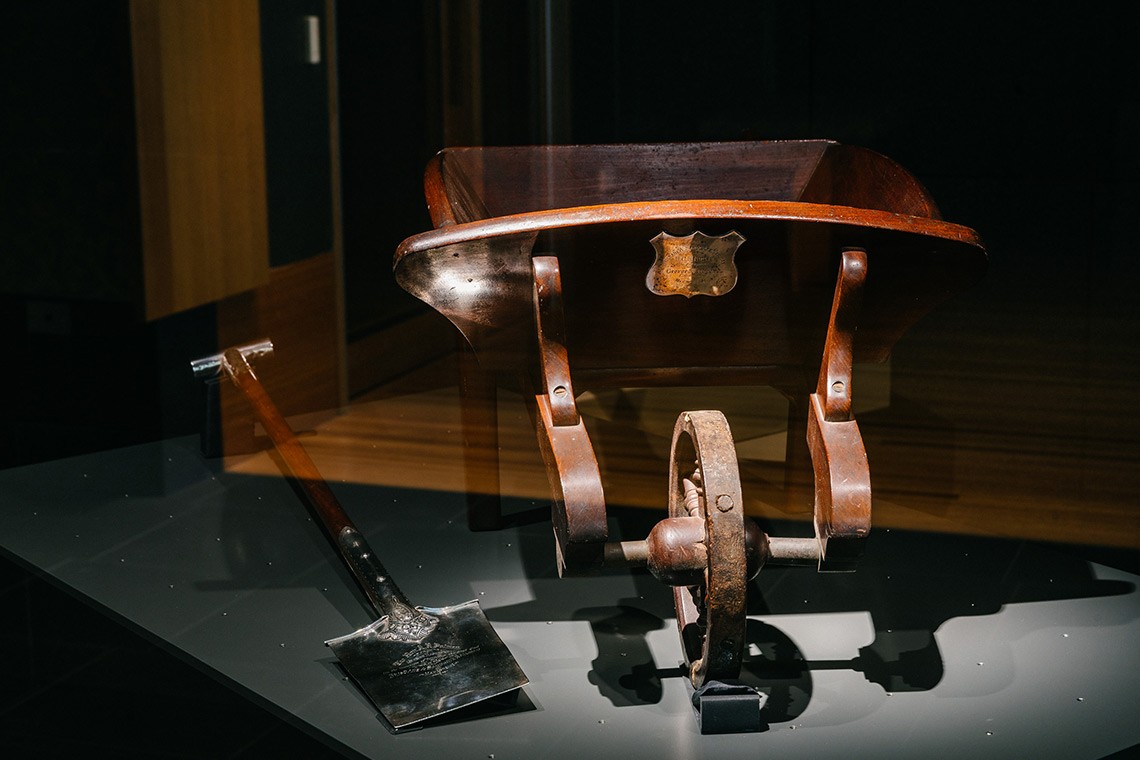
Arthur Palmer Presentation Spade and Wheelbarrow, 1881
Boodle & Dunthorne
The nickel silver spade and timber wheelbarrow were presented to Arthur Palmer, former Queensland Premier and current Colonial Secretary, at a ceremony held at the Brisbane Exhibition grounds to mark the turning of the first sod in the building of the Sandgate Railway on the 10th May 1881. The Sandgate Railway, which opened in 1882, was built to provide convenient access to the seaside for the city’s residents as well as visitors from interstate, opening the area as a tourist destination. Travel between Brisbane and Sandgate could be completed in under half an hour with the advent of rail.
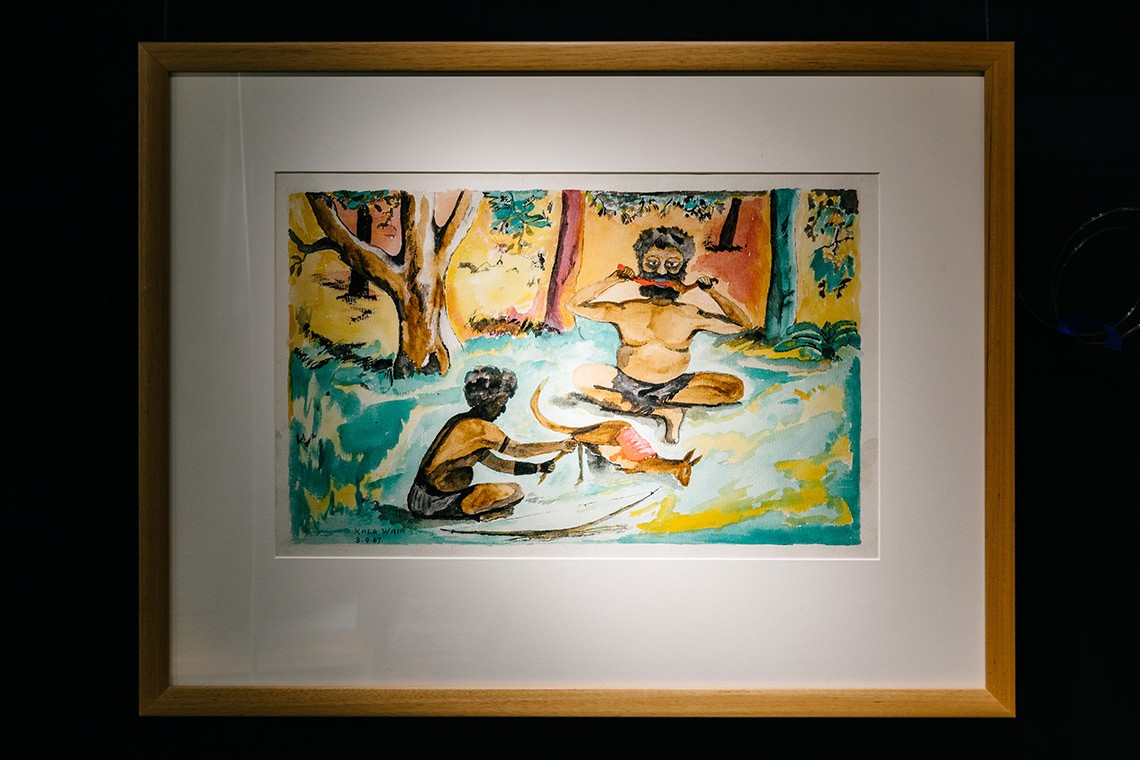
'Baira and Agburug (as man)', 1967
Kala Waia
This watercolour painting by Kala Waia is entitled “Baira and Agburug (as man)” and illustrates the Torres Strait Islands legend of Agburug. The legend tells the story of the friendship between Baira from Saibai Island and Agburug who could take the form of either man or snake. The legend was told to Margaret Lawrie by Nawia Elu, great-grandson of Baira, at Saibai Island on 29 August 1967, in preparation of the book Myths and Legends of the Torres Strait which was originally published in 1970. In this book, Margaret Lawrie, working closely with the people of the Torres Strait, attempted to preserve as faithfully as possible the myths and legends related to her by the islanders. The painting was done in 1967 by Kala Waia from Saibai Island to illustrate the book.
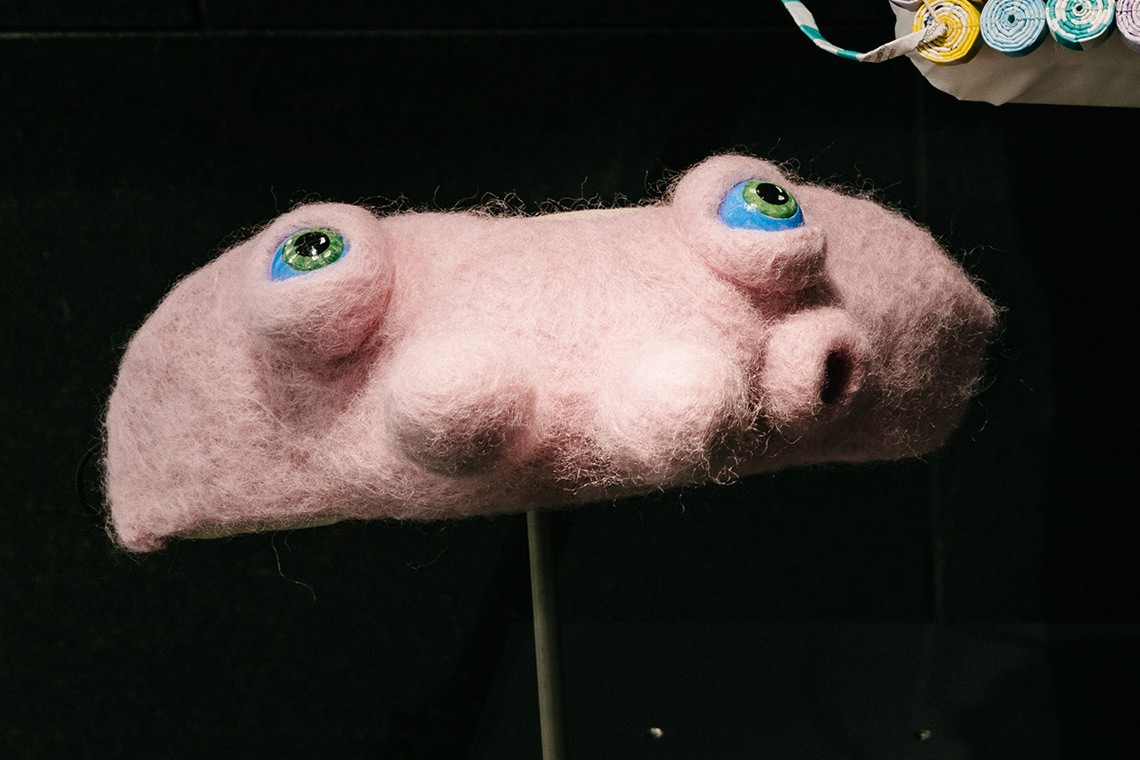
Alienation, 2020
Lulu Geraghty
Alienation was created by Lulu Geraghty as a “reflection on a shift from feelings of anxiety to curiosity and hope during self- isolation”.
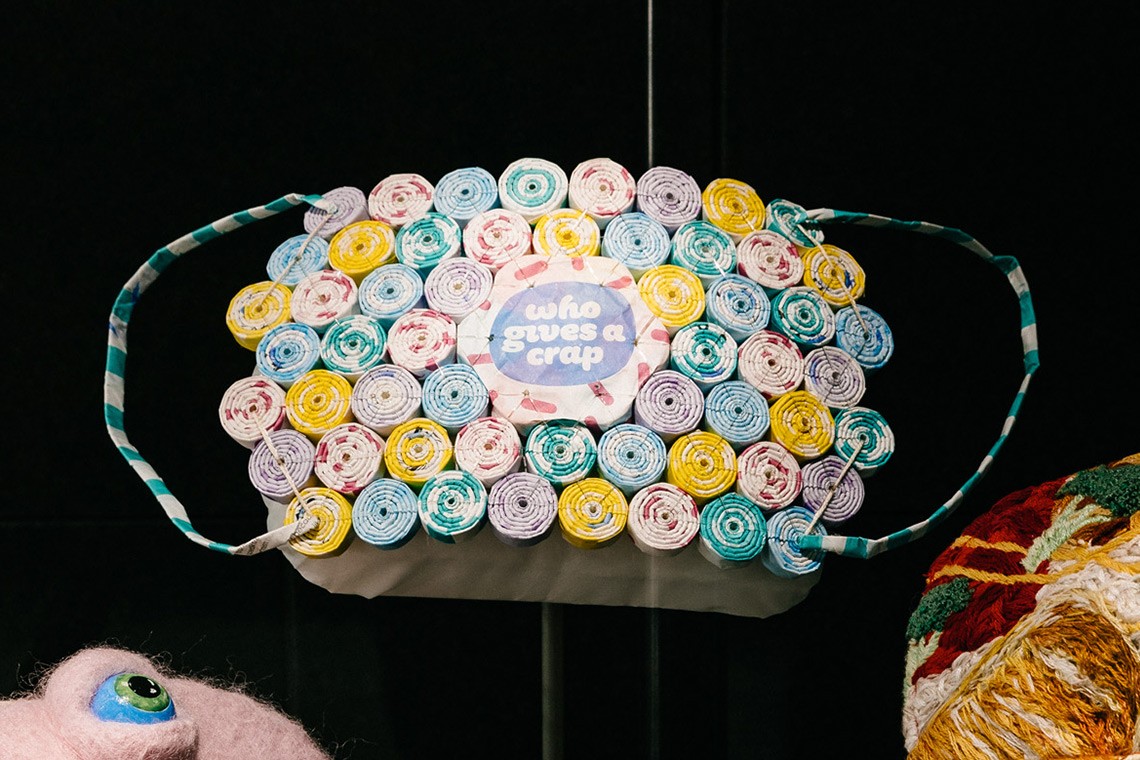
Masking shortages, 2020
Denise Lamby
Masking Shortages was created by Denise Lamby and is constructed from the recycled paper wrapping of “Who Gives a Crap” toilet paper which is a reflection of the public’s indifference to Covid-19 before it had reached Australia.
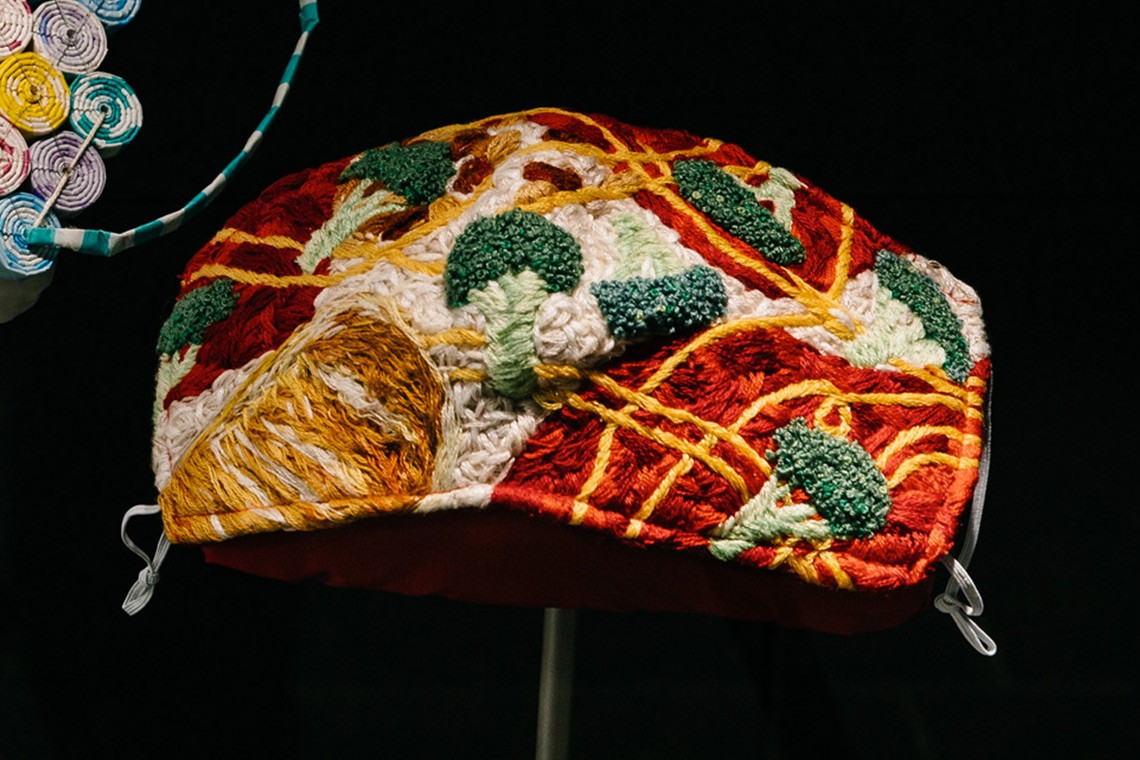
Covid-19 made me buy it, 2020
Akino Kato
Covid-19 made me buy it was created by Akino Kao and reflects on supermarket shelves being stripped bare during Covid-19 lockdowns.
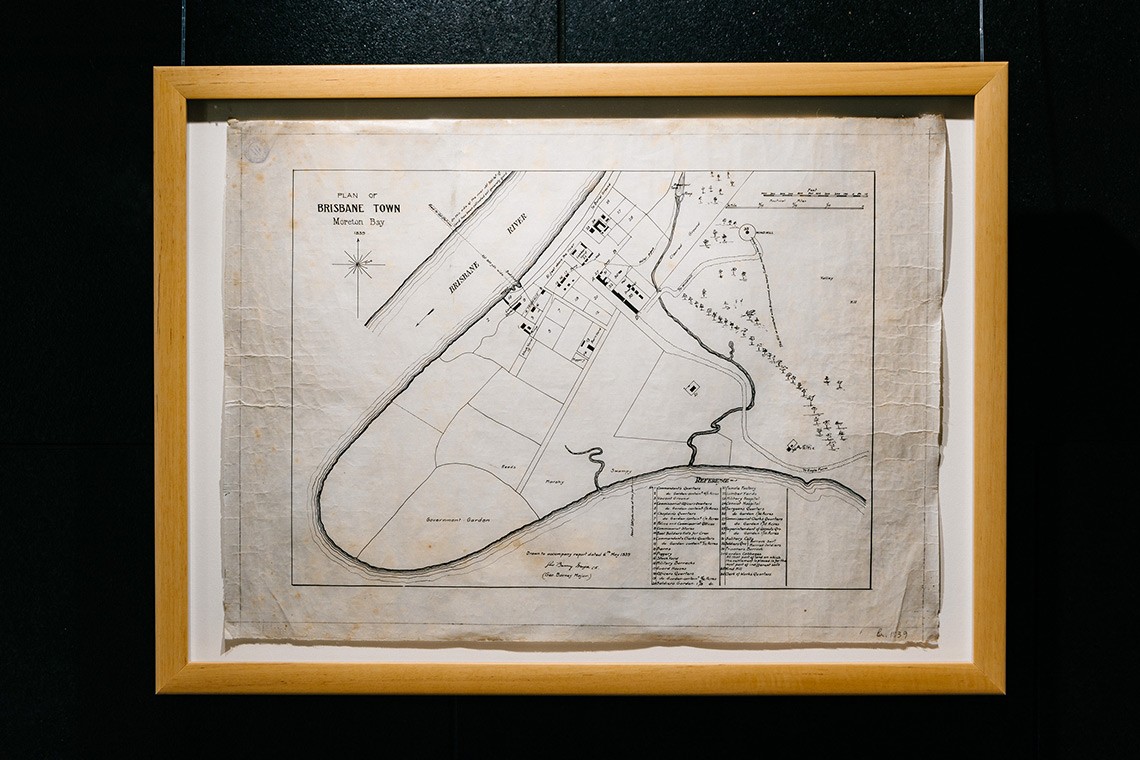
Plan of Brisbane town, Moreton Bay, 1839
George Barney (1792-1862)
This is the earliest known map of Brisbane. Drawn by colonial engineer, George Barney, the map accompanied a report sent to Governor Gipps in May 1839, in preparation for the opening of Moreton Bay for free settlement. The Brisbane area was first settled by the British in 1824 with a penal colony established for repeat offenders under the direction of Sir Thomas Brisbane. It gained a reputation as one of the harshest penal settlements in the colony. By the beginning of July 1839 all convicts, except those considered essential for assisting with surveying and other government work had been removed. The two convict constructed buildings which remain on the site today are the Commissariat Stores and the Windmill on Wickham Terrace.
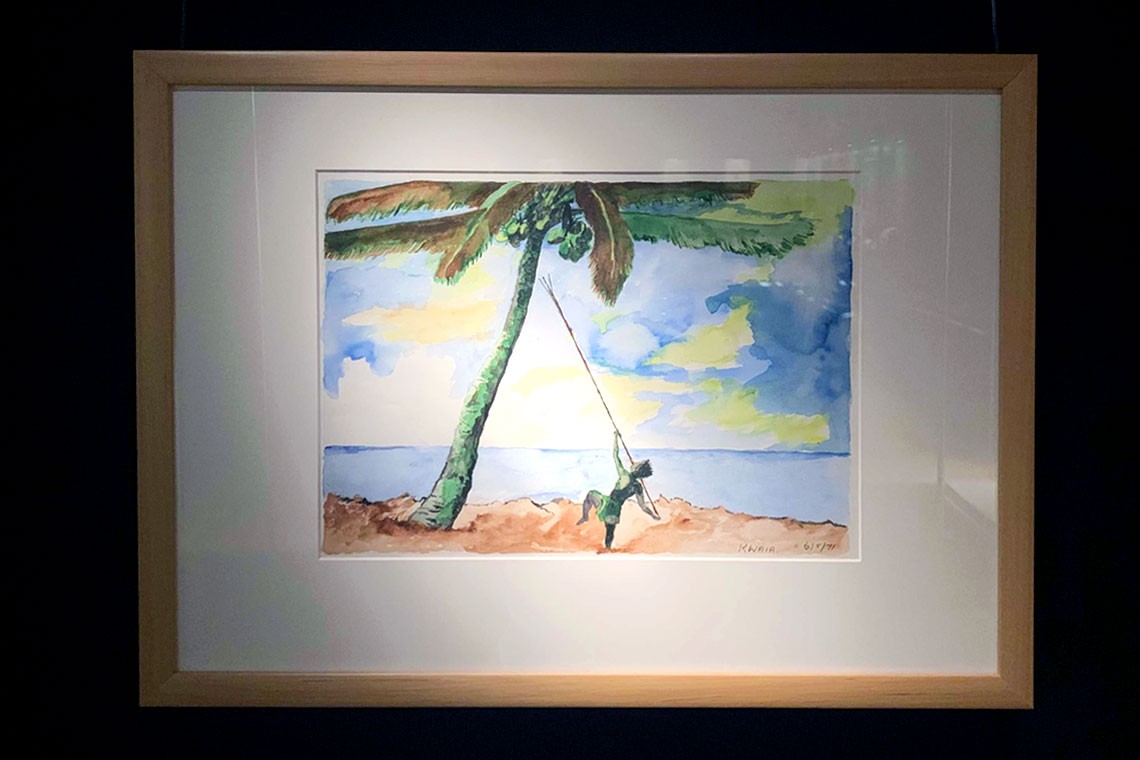
'Man with three-pronged stick retrieving coconuts' from the ‘Baira and Agburug (as man)’ series, 1967
Kala Waia
This watercolour painting by Kala Waia is entitled 'Man with three-pronged stick retrieving coconuts' and may illustrate the Saibai Island story of Mibu. The painting depicts Mibu knocking down coconuts from high in a tree with a long three-pronged fish spear.
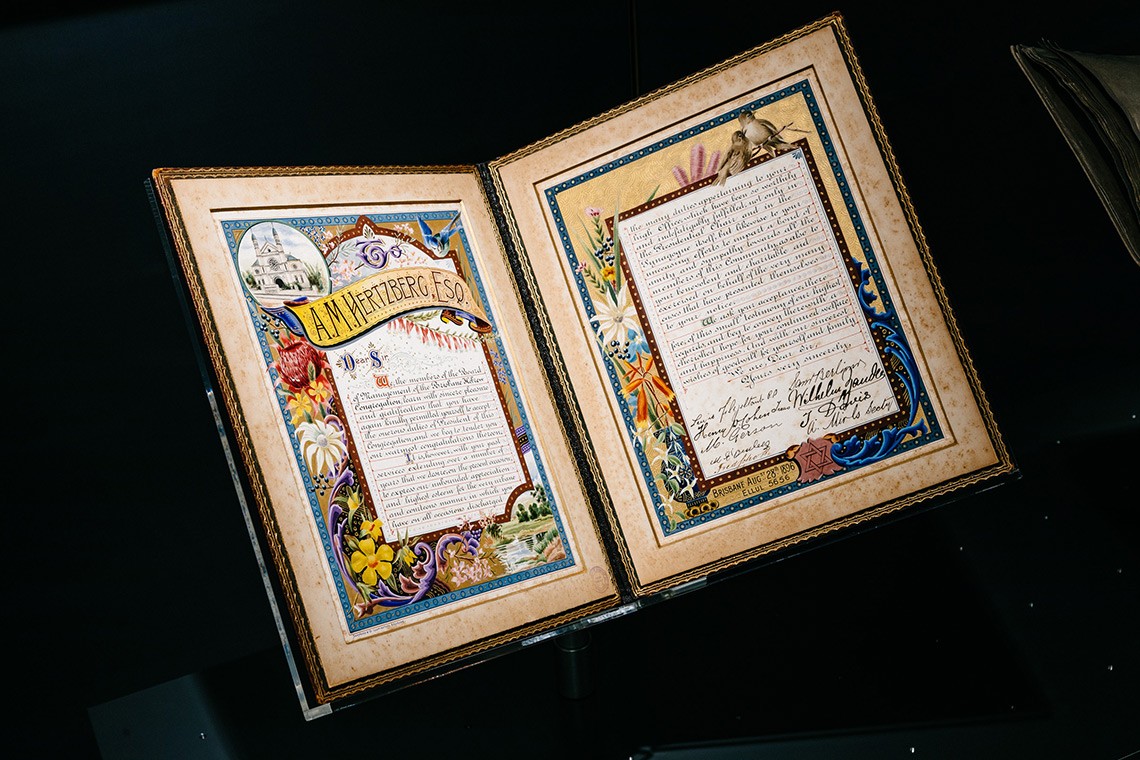
Illuminated address, 1896
Sapsford and Co
On the 28th August 1896, this beautiful illuminated address was presented to Adolphus Marcus Hertzberg, President of the Brisbane Hebrew Congregation, by the members of the Board of Management of the congregation to acknowledge his many years of service. Hertzberg, who emigrated from Prussia to Queensland in 1867, contributed greatly to the public life of Brisbane, serving as President of the Chamber of Commerce, Grand Master of the Masonic Lodge of Queensland, and as President of the Brisbane Hebrew Congregation for 16 years.
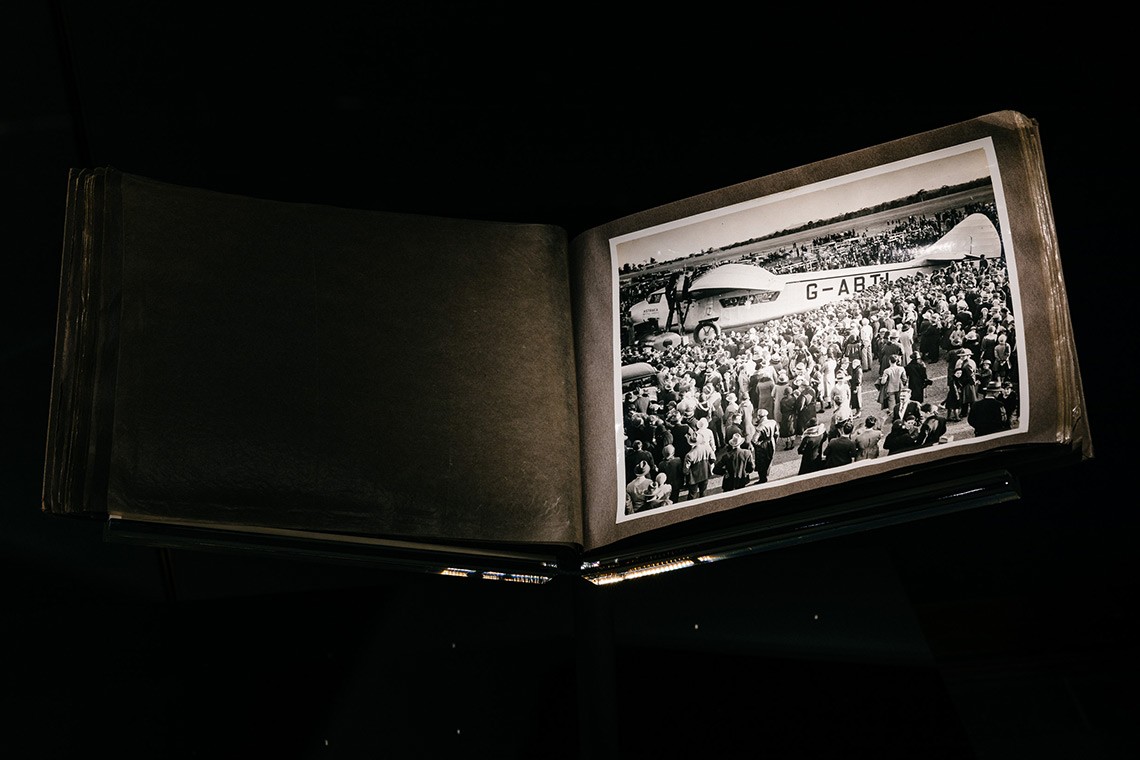
‘Astraea’ in Brisbane Photograph Album, 1933
Qantas
In June 1933, the British Imperial Airways liner ‘Astraea’ G-ABTL, commanded by Major H. G. Brackley, arrived in Australia on a goodwill and business mission, and visited Brisbane from 23- 26 June. The main objective was to arrange with Qantas Ltd. for the operation of the Australian section of the projected England-Australian passenger and airmail service. The Managing Director of Qantas, Hudson Fysh, was a passenger on the ‘Astraea’ on the return flight to England. The following year, on 18 January 1934, Qantas and Imperial Airways entered into a partnership to form a new company, Qantas Empire Airways Ltd. The 1933 flight of the ‘Astraea’ led to Qantas becoming an international airline.
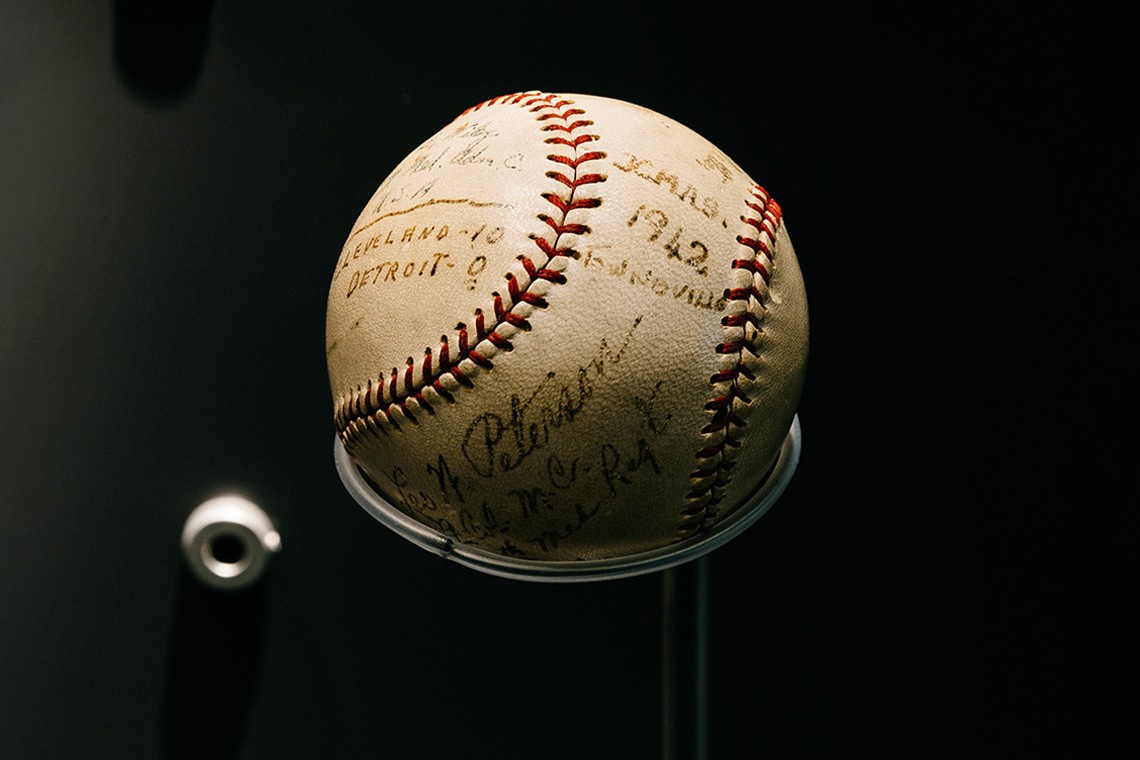
World War II American Baseball, 1942
Gustavus John Birch, 1820-1883
This American baseball was used by some of the first American servicemen stationed in north Queensland during World War II. It was used in a game held in Townsville on Christmas Day 1942. The baseball displays the signatures of the American soldiers who played in the game while they were stationed in Townsville. Signatures include those of First Lieutenant Irving Wiley, Lieutenant Colonel Les Petersen, Captain M.C. Edward Vettes, and First Lieutenant George Lehman. The result of the game is recorded on the ball – ‘Cleveland 10 / Detroit 0’.
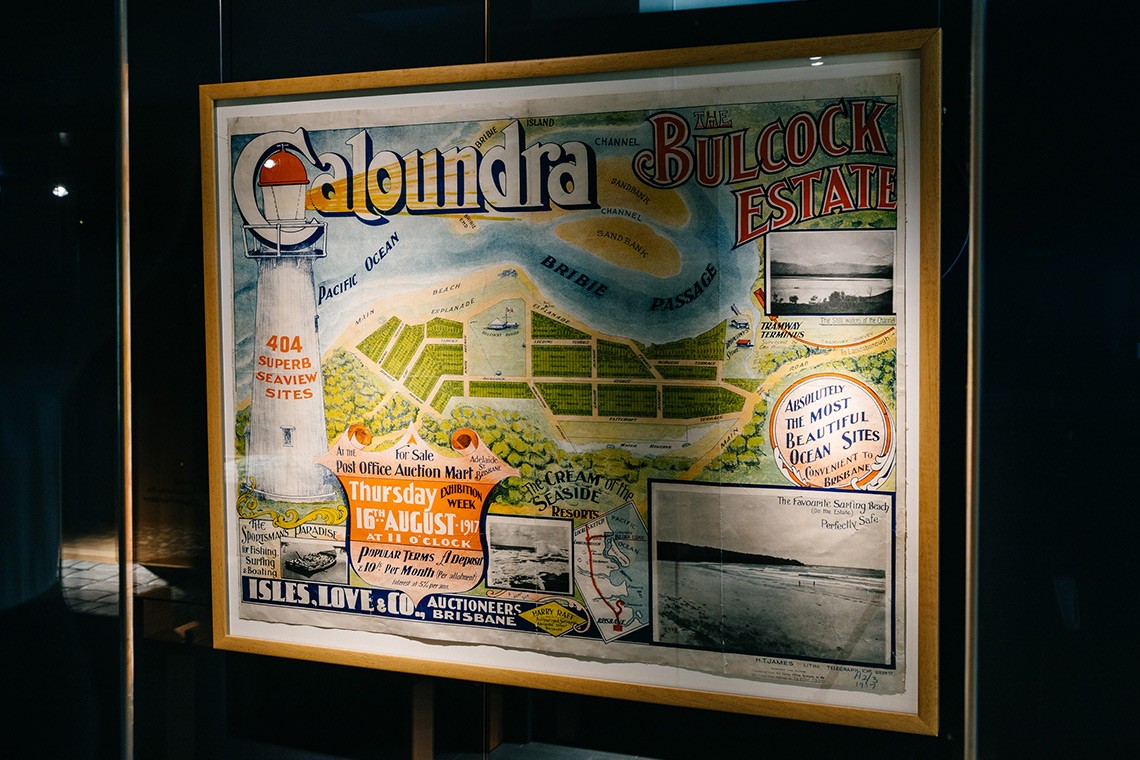
Bulcock Estate Caloundra [Real Estate Map], 1917
George Phillips and Harry Raff
This real estate map from 1917 advertises 404 allotments of land for sale at the Bulcock Estate in Caloundra on the Sunshine Coast which were auctioned on the 16th August 1917. The allotments for sale were situated along Bulcock Street, The Esplanade, Warne Terrace, Dingle Avenue, Knox Avenue, Minchinton Street, Leeding Terrace, Grigor Avenue (now Otranto Avenue), Flitcroft Terrace (now Omrah Avenue), Ferris Avenue (now Tay Avenue and Centaur Street), Burgess Terrace (now Maloja Avenue) and Gay Terrace (now Lower Gay Terrace). The map also shows the property Bulcock’s House (also known as The Homestead) which was built in 1878 by Robert Bulcock. Prior to the sale extensive publicity was published in Brisbane newspapers: “The only seaside in South Queensland where mosquitoes and sandflies don’t pester your life out. The Bulcock Estate has also the advantage of the smooth-water frontage inside the bar, and the fishing, bathing, are unequalled.” (Daily Mail, August 11, 1917)
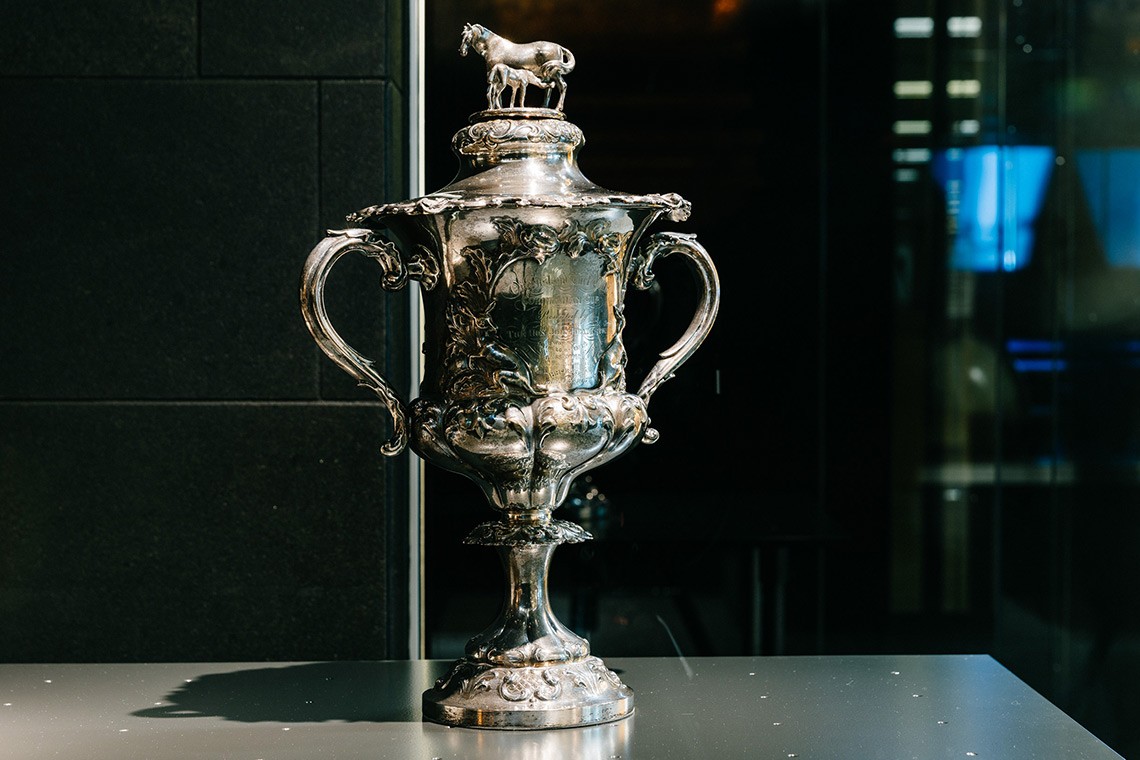
Corinthian Cup, 1855
Hayne and Cater, London
Sterling Silver Cup presented by the Hon. John Bramston, Leader of the Queensland Legislative Council to his friend Robert George Wyndham Herbert, first Premier of Queensland, whose grey gelding “Grasshopper” was the winner of the Queensland Turf Club’s Corinthian Handicap Race, a feature race for gentleman riders run at the inaugural race meeting at Eagle Farm Racecourse, August 1865. Herbert’s cousin Algernon Lempriere was the rider. The cup bears the hallmark of Hayne and Cater, London based merchants, manufacturers, wholesale silversmiths and silver spoon and fork makers.
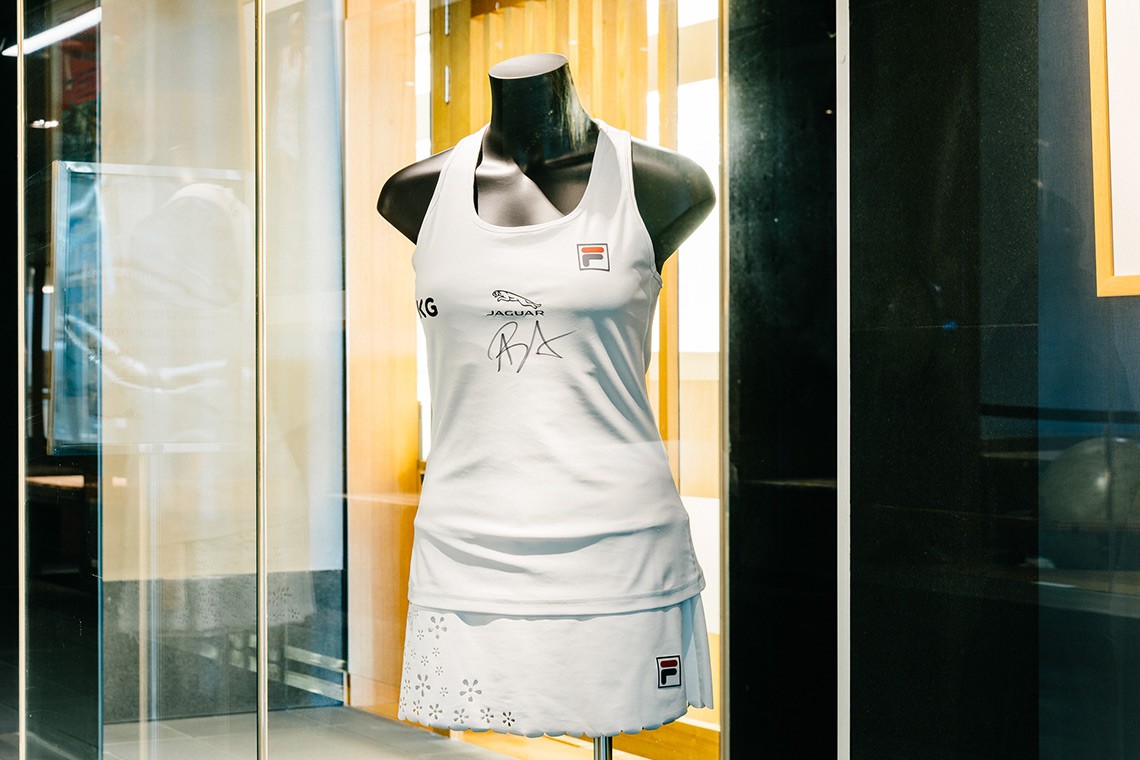
Ashleigh Barty Wimbledon 2021 skort and top, 2021
Fila
White, scallop-hemmed skort and top made for Australian tennis champion Ash Barty to wear during her 2021 Wimbledon campaign. The dress pays tribute to Barty’s fellow Indigenous Australian Evonne Goolagong Cawley, and commemorates the 50th anniversary of Cawley’s momentous first Wimbledon singles title in 1971. The scallops and floral features of Barty’s outfit were inspired by the outfits designed for Goologong Cawley by renowned British couturier Ted Tinling. While the flowers on Goolagong Cawley’s outfits were embroidered with coloured thread, the flowers on Barty’s skort and top were laser cut from the fabric.
Read more about Ash Barty's iconic Grand Slam outfits which are now part of the collection.
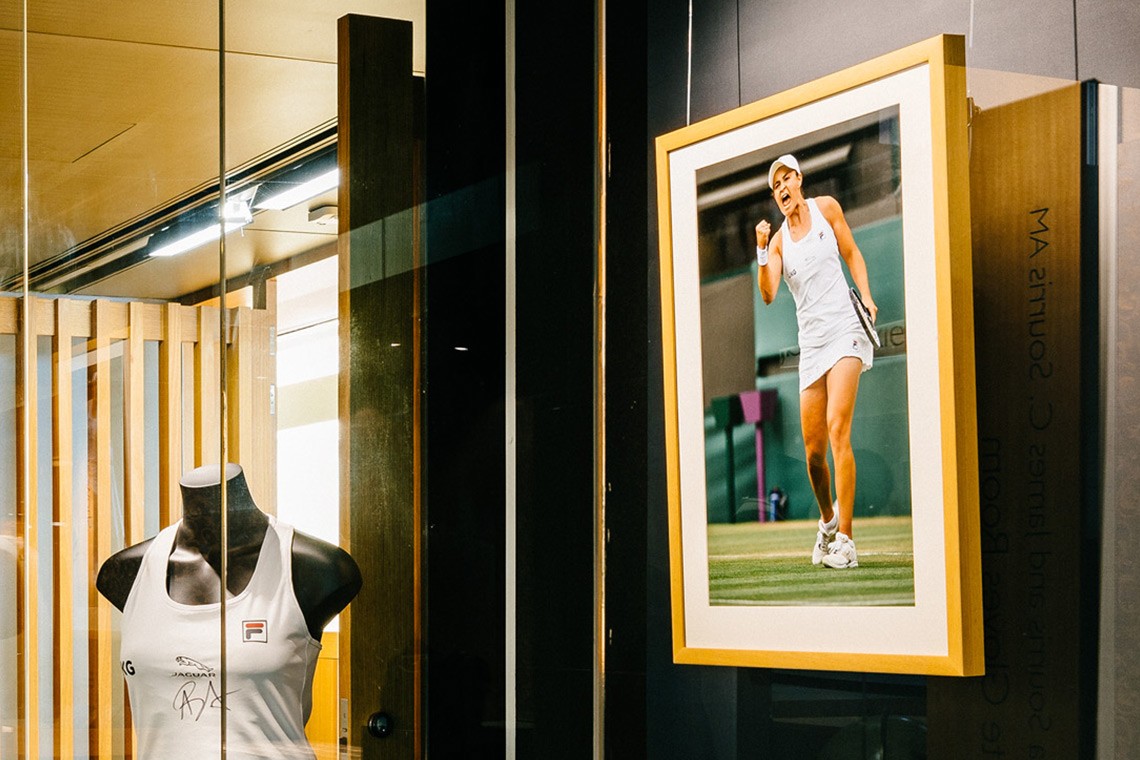
Ash Barty in action at Wimbledon, 2021
Image courtesy of FILA
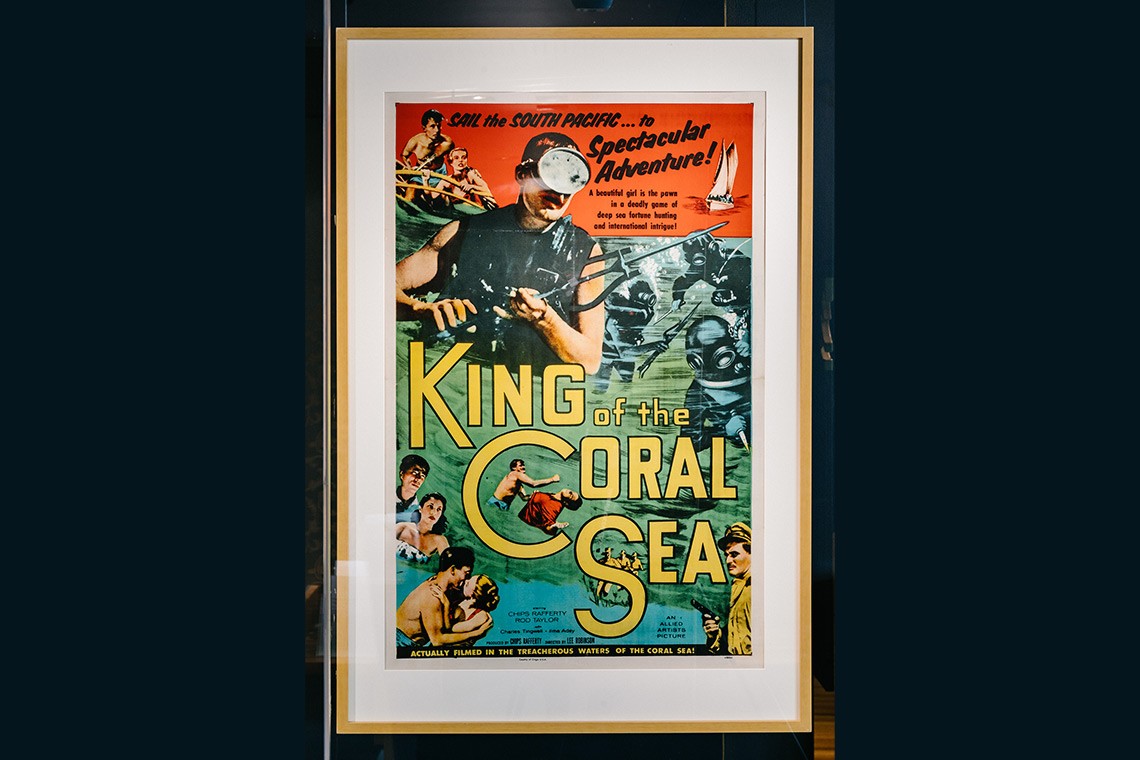
King of the Coral Sea, 1954
Southern International Films Pty. Ltd. (issuing body)
This colour lithograph poster was created to promote the 1954 Australian film King of the Coral Sea, produced by Southern Films International and distributed by British Empire films. The movie starred Chips Rafferty and Charles Tingwell and was directed by Lee Robinson. It marked the feature film debut of Australian actor, Rod Taylor. The movie was shot on location on Thursday Island, with the underwater scenes filmed in the waters of Green Island, off the coast of Cairns. The movie was noted for the documentation of pearl shell divers and their vessels and was one of the most commercially successful Australian films of the 1950s.